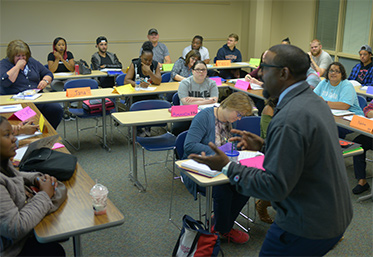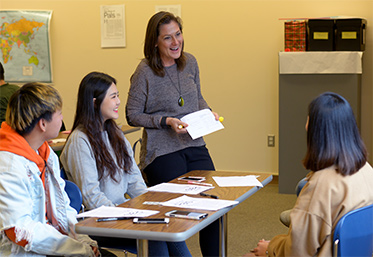
An Inclusive Pedagogy (IP) Framework for Pierce College
Purpose
- Scaling/implementing IP is critical to serving our entire community, particularly students from systemically non-dominant communities (Jenkins).
- What does it look like to practice inclusive pedagogy at Pierce College? The IP Framework is a living and evolving document that offers concrete and dynamic answers to this question.
- The framework is both aspirational and based in accountability.
- It acknowledges that all members of our institutional ecosystem are both learners and teachers.
Source: Jenkins, D. (1995-present). IST of an ISM Paradigm. Share the Flame: Vancouver, WA
Definition
Inclusive pedagogy creates teaching and learning opportunities that are welcoming, proactive, responsive, and affirm the complexities of all our learners.
Inclusive pedagogy is a long-standing, evidence-based area of study that is rooted in racial and social justice. It thus recognizes that the varied backgrounds, physical, intellectual, emotional, and social abilities of historically marginalized communities are centered to accurately capture the complexities of our vast humanity.
An ecological approach, applied to social institutions, centers the ways that both humans (body, mind, and spirit) and structures (political, economic, cultural, and social) interact/impact each other in the process of creating 'balance.'
At Pierce College, we use an ecological approach to build collective teacher efficacy that ensures inclusive practices and advances equity. Guiding principles include equitability, critical self-reflection, flexibility, transparency, and culturally responsive and sustaining pedagogies, intercultural engagement, relationships, collaboration.


Guiding Principles
- Equitability
- Explicitly included within the other principles
- Critical self-reflection
- Flexibility
- Transparency
- Culturally responsive pedagogies (currently shifting to "culturally sustaining pedagogies")
- Intercultural engagement
- Relationships
- Collaboration
These principles are interdependent and cannot be considered entirely separate from one another, as they overlap and rely on each other.
The IP framework examines each of these principles at the classroom, department/division, and institutional levels. This page for faculty is focused on the classroom impact of the IP principles. IP work at other levels in the institution is also happening.
Equitability
- Equity - Intentionally tailoring resources that fit the individual with respect to their multi-dimensional perspectives and needs.
- Inclusion - Broadening the circle, inviting and welcoming others into interaction by recognizing, valuing and celebrating contributions that provide depth, better outcomes, and lead to transformational change.
- Diversity - Diversity is a reality of the human experience; it’s how we present in the world. We each experience life from multiple dimensions and perspectives. Put simply, diversity may be seen as the variety of human differences and how they intersect with your life experiences.
Equitability is explicitly centered within each pillar.
Source: Pierce College EDI CARES
Critical Self-Reflection
Critical self-reflection refers to the process of questioning one's own assumption, presuppositions, and meaning perspectives. (Mezirow, 2006)
In the Classroom
- Faculty reflect on how their teaching practices impact vulnerable students.
- Is this classroom policy actively anti-racist? Anti-ableist? Anti-classist?
- Does this policy further marginalize BIPOC students, disabled students, or single parents?
- Faculty also teach students how to engage in critical self-reflection.
- Students explore their own positionality
- Where applicable, students can then prepare to use their privilege to challenge the status quo in society.
Flexibility
Responding and adapting empathetically to students' [and others’] changing and diverse circumstances. (Dr. Tazin Daniels)
In the Classroom
- Universal Design for Learning principles
- Present materials in multiple ways
- Allow multiple ways for students to demonstrate their learning
- Flexible due dates and assignment options support students navigating challenges outside the classroom, while providing instructors an opportunity to practice culturally responsive teaching.
- Critical self-reflection helps illuminate which practices perpetuate inequity. Flexibility allows us to seek alternatives to "how it has always been done".
Transparency
- State of being characterized by visibility or accessibility of information. (Merriam-Webster)
- Clarity about the purpose, task, and criteria of learning activities and assignments. (Mary-Ann Winklemes)
In the Classroom
- Faculty follow the TILT framework for assessments, to ensure students understand:
- Purpose
- Task
- Criteria for Success
- Course expectations and policies are clearly expressed in multiple ways, to reduce miscommunication and improve clarity.
Culturally Sustaining Pedagogy
Culturally Sustaining Pedagogy views schools as places where the cultural ways of being in communities of color are valued, centered, and sustained, rather than eradicated.
Culturally Sustaining Pedagogy promotes [equity] across racial and ethnic communities and seeks to ensure access and opportunity.
Culturally Sustaining Pedagogy also supports students to critique and question dominant power structures in societies.
In the Classroom
- Highlight and center the work of Black, Indigenous, People of Color scholars in our fields
- Allow for multiple ways of knowing and ways to show up in class and in the course
- Agency in assignments
- Move away from punitive measures
- Interrogate policies- do they sustain cultural ways of being for communities of color?
- Make space for linguistic diversity
- Acknowledge and interrogate power dynamics and structures in the classroom, curriculum, and policies
- Co-create knowledge with students
- Collaborate to succeed vs. compete to succeed
References
Culturally Sustaining Pedagogy builds on decades of asset-based pedagogical research including Culturally Relevant Pedagogy (Ladson-Billings) and Culturally Responsive (Gay and Hammond) and Linguistic (Hollie) Pedagogy.
- Django Paris and H. Samy Alim describe the key features across culturally sustaining educational settings in an Education Week Author Interview: ‘Culturally Sustaining Pedagogies’
- California Dept of Education
- See p.20 of ATD’s Teaching & Learning with Open Educational Resources
Intercultural Engagement
Centered in relationships, intercultural engagement works to engage people within the complexities of their cultures, identities, and positionalities. It also works to bring cultures into communication with each other.
This is connected to our Core Ability Intercultural Engagement.
In the Classroom
- Skillfully challenge others’ harmful and stereotyping behaviors
- Allow for agency in ways to approach an assignment and in how much is shared
- Prioritize community building activities
- Invite student expertise into discussion and assignments
- Model cultural brilliance / Practice cultural humility / L.O.V.E. (Listen, Observe, Value and Validate, Embrace and Empower)
- Ensure classroom materials/readings/videos/images represent many cultures, deliberately centering the brilliance and voices of Black, Indigenous, and other people of color
- Highlight different types of global English as well as other languages
- Bring in diverse perspectives and cultures into classroom spaces
Resources
- University of Michigan: Equity-focused Principles, Strategies & Resources, particularly the section on Critical Engagement of Difference.
Relationships
- How we see, value, interact and connect with each other
- Willingness to really connect with others and to give time and heart to their ways of being and their lived realities
- Willingness to affirm and support but also advocate for others
- Willingness to be vulnerable and uncomfortable and to have difficult conversations and engage in repair work when necessary
- Willingness to sacrifice, decrease, and or give up positionality, resources, and privileges
In the Classroom
- Love students and do no harm
- L.O.V.E – Listen, Observe, Value & Validate, Embrace & Empower (James Lett)
- Go to where students are
- Regular communication in spaces the students are already in
- Build relationships with students on their own terms, without assumption or judgement
- Cultivate belonging
- Studies show that retention of students from marginalized communities, particularly in STEM fields, is strongly correlated to that sense of belonging
- Genuine care that students are present
- Learn and use students’ names and pronouns
- Prioritize community building
- Do repair work
- Be transparent about own positionality
- Facilitate dialogue between students using a co-constructed framework of classroom norms
- Engage in regular communication / transparency in communication habits
- Checking in with how students are doing
- Reaching out when students don’t show up in assignments
- Giving kudos on Starfish
- Integrate storytelling / identity metacognitive work into the course
Collaboration
Successful collaboration has the following defining characteristics:
- Collaboration is voluntary;
- Collaboration requires parity among participants;
- Collaboration is based on mutual goals;
- Collaboration depends on shared responsibility for participation and decision making;
- Individuals who collaborate share their resources;
- Individuals who collaborate share accountability for outcomes.
(Friend and Cook)
In the Classroom
- Course outcomes value and expect collaboration between students.
- Faculty collaborate with students to create resources through open education pedagogy and practices.
- Undergraduate research and service learning provide opportunities for collaboration.
- Move from the idea of work to the concept of meaningful mission, the vita activa. (Powell and Kusuma-Powell, Arendt)

